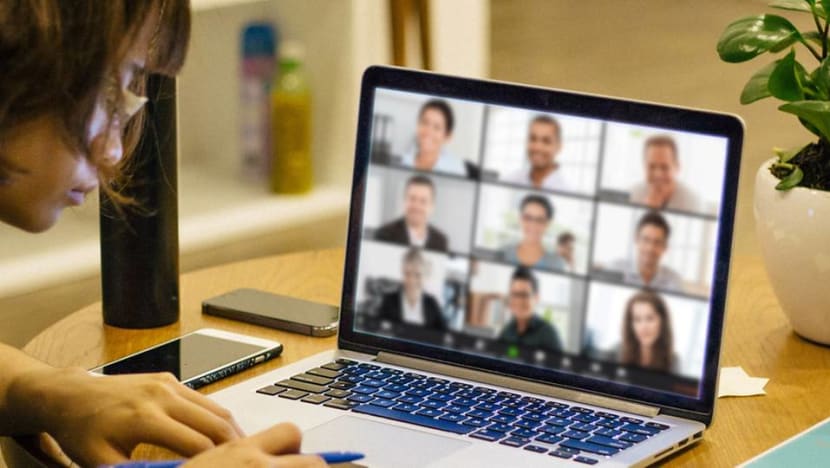commentary Commentary
Commentary: COVID-19 has stripped work to bare bones - was all that excess needed anyway?
The coronavirus outbreak has transformed the working world. But the biggest question may be what took us so long to make that leap into remote working in the first place, asks Crispina Robert.

(Photo: Unsplash/Christopher Gower)
SINGAPORE: I am sitting at my desk in the study, looking out the window where the clouds are gathering steam for a thunderstorm.
I am reminded of all the times I woke up with a headache or a sinus inflammation and wished I could just stay home and get to work without any distractions instead of having to drag my feet and pull in the physical hours at my cubicle.
I know of friends who needed peace and quiet, and decided to just take their own leave to work from home, particularly if they needed to read, write and plan.
But just like that, with the coronavirus outbreak forcing companies to migrate to remote working and here we are, in what feels like an alternate universe.
LISTEN: Disruption 101: How COVID-19 is revolutionising work
READ: Commentary: Remote working promised freedom, but seems to be delivering the exact opposite
Despite the majority of the population working from home, the engine is still turning, the sky is seemingly intact. There is no wasted time on the road or in the air, no long drawn meetings, no idle chit chat at the pantry (although I do miss the chit chat).
Our entire work experience this year can be summed up by this popular meme on the Internet: “That was a meeting that could have been an email.”
WHAT TOOK US SO LONG?
So the question is: Why were companies so reluctant to push more telecommuting options for their staff? If it were an option, it was reserved for some groups – mostly women with children or those with medical problems.
If it were extended to everyone, it came with a list of caveats. In many workplaces, pre-COVID-19 telecommuting was a special privilege – in my previous workplace, it was always during term break, once a week and fixed.

If you had meetings on your telecommuting days, too bad, you came in.
What was behind our general aversion to allowing people to work from home, especially if they found it more productive?
‘FUNDAMENTAL CONSERVATISM’
Howard Yu, MD Business School LEGO Professor of Management and Innovation called it “fundamental conservatism”. Simply put, most bosses believe that when employees are absent, they are not working.
This is the idea that your input (how many hours you were seen to be putting in) had a direct relationship to your output (the work you produced).
In the last episode of Heart of the Matter podcast, Howard talks about working with MNCs who simply couldn’t and didn’t want to make the needed changes so that more of the work can be done away from the office.
A company’s management, their boards and their investors – everyone needed to be convinced with a multitude of business plans and meetings.
“It took a pandemic that no one can oppose any more to move to a new world,’’ he says. These new times are demanding companies to reverse our input and outcome formula he adds. “Don’t tell your employees how you want to achieve something but what you want to achieve.’’
Still, conservative attitudes were only part of the inertia. The other critical component was also the tech infrastructure – IT systems needed to be robust and be able to support people who needed to have secure off-site work spaces.
As we are all beginning to realise, a strong IT department is critically important in any company and investments need to be made for this to be robust. Tech know-how should also be part of everyone’s training and not just left to the hands of the few. This way, everyone can execute basic protocols when it comes to safeguarding work online.
READ: Commentary: COVID-19 – as offices close, hackers work overtime
READ: Commentary: The time of introverts has come as firms ramp up work-from-home arrangements
COMMUNICATING EXPECTATIONS
It is true that this “free-wheeling” system does depend heavily on the work ethic of individuals.
By and large, most people do want to put in an honest day’s work and will do what is expected of them. Some, invariably, will take advantage but that shouldn’t detract us from looking at how the benefits may outweigh the negatives.

Besides, as Howard points out, it is impossible for bosses to mandate how their staff spend their time in this new digital work environment. The sensible thing to do is to make expectations and communications clear and trust that everyone will do their part.
Our other guest on the podcast, Boston Consulting Group Managing Director and Partner Michael Tan says the most immediate benefit is how much time and money is saved. The biggest outcome for him though is that businesses are forced to become “flatter, more nimble’’.
FINALLY, SOME BALANCE?
In our chats with people who are working from home, most say the biggest benefit is that so much time is freed up by just not having to travel. They can use that time to do things that matter to them and their families.
In my case, I save two full hours a day of travel time. Like so many folks, I have used that time to exercise, cook, clean the house and be an early supermarket shopper. Just not being part of the rush hour crowd on the morning commute must have added much collagen back into my ageing skin.
On the other hand, others complain that they work longer. When there isn’t a separation of work and home it is easy to keep going and before you know it, you've been at your dining or study table for 12 hours.
READ: Commentary: How Zoom-working will change companies forever
READ: Commentary: 5 tips to ace leading a team while working from home
From my social media feed, I can see parents struggle when they have small children to attend to.
So there are no perfect solutions and a lot of it depends on the type of work you do, your role and how much support you have – both in your home and from your employer.
OUR REMARKABLE INGENUITY
There is however something everyone has in common – a deeper and hopefully more significant outcome. For my current work, which involves meeting people, going into the studio and recording, this was not easy.
I was forced to adapt and am learning many interesting things along the way. I would say, that’s the case with teachers, doctors, even insurance agents who have had to find ways to continue working without meeting clients.
I even spotted a virtual emcee who was working from his home! (Much like how people are socializing online, this emcee is the paid host in a virtual party). So our ingenuity can be quite remarkable.
As our guests have rightly said, this massive work from home experiment is really the chance to scale up and transform our work lives in the long run.
To prepare for a post COVID-19 world, companies can start by looking at this gift horse squarely in the mouth to chart a new course that would involve more work being done anywhere – not just in one physical space.
Our health, the environment, our families and yes, especially our work, will be the better for it.
BOOKMARK THIS: Our comprehensive coverage of the coronavirus outbreak and its developments
Download our app or subscribe to our Telegram channel for the latest updates on the COVID-19 outbreak: https://cna.asia/telegram
Crispina Robert is an editor at CNA Digital News where she oversees podcasts.















